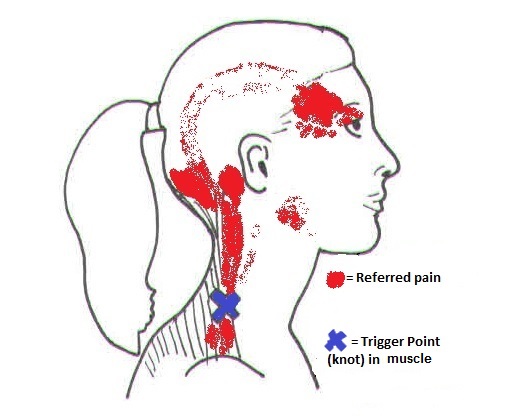What causes tension headaches?
Tension headaches are caused by tension and “trigger points” in the muscles of the scalp, neck and shoulders. This may be due to stress, poor posture, repetitive strain from long hours at a computer, muscle spasm due to injury to the discs and joints in the upper spine, as well as some metabolic disorders.
What are trigger points?
Trigger points are essentially hyper-tight knots in taught bands of muscle that can cause referred pain. The mechanism behind referred pain is similar to a crossed line on the telephone, whereby a nerve ending from a muscle knot is so sensitised that it causes a cross-over signal to a different nerve to another part of the body. Common trigger points involved in tension headaches occur at the top of the shoulders (trapezius muscles) and base of the skull. They cause characteristic patterns of referred pain over the side of the head, often towards the eye, as illustrated in red in the diagram, below.

How can manual therapy help tension headaches?
Your therapist may show you stretching and strengthening exercises to do. However, whilst it is important to correct causal and maintaining factors such as poor posture, exercises alone are not usually enough to get rid of trigger points once they have formed. In the same way that it is necessary to repair a crack in the wall as well as the faulty foundations that may have caused it, direct hands-on treatment is usually necessary to facilitate repair and relaxation in relevant trigger points. One of the best forms of manual therapy is “Trigger Point Massage”, which takes considerable skill and involves firm, slow, low amplitude and sustained massage strokes with very little or no oil. Massage strokes must be performed in a way that stretches the taught bands of muscles but without irritating the over-active stretch receptors present within the trigger points. If massage is performed too fast or without firm contact on the muscle bands, the result can be like flicking over a guitar string, resulting in increased activity of the stretch receptors, increased trigger point tension and increased tension headaches. However, when performed in the right way, this method of treatment can be extremely effective, not only at reducing chronic muscle tension, but also at reducing the oversensitivity in the nervous system present in those suffering from chronic tension headaches and associated disorders, such as Fibromyalgia. This often allows patients to reduce, or in some cases completely stop, their muscle relaxant and (neuropathic) pain modulating medication. When combined with medical acupuncture the treatment effects are usually further enhanced.
What is medical acupuncture?
Medical acupuncture involves the insertion of relatively few acupuncture needles into relevant trigger points determined from the patients description of their pain and the practitioners palpation. The approach of medical acupuncture is more scientific than traditional acupuncture. Needles can be used to reach deep bands of muscles that are difficult or impossible to isolate, even with finger-tip deep massage. A distinctive “twitch response” is produced when successfully hitting a trigger point, increased blood flow to the area will usually follow, accompanied by relaxation of the trigger point and a reduction in its referred pain. Pin-point accuracy when inserting needles is essential to achieve this twitch response. If it’s not initially achieved, moving the needle(s) just a millimetre or two can make all the difference to a successful treatment outcome.
